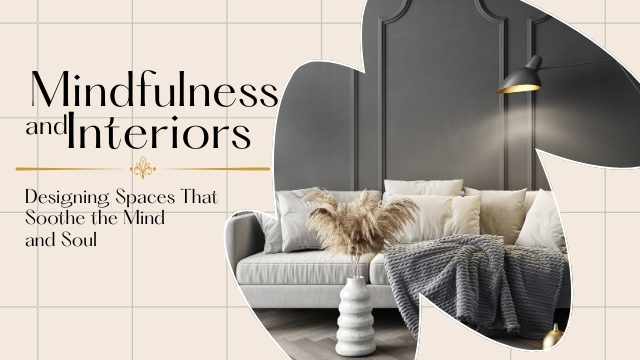In a time where the outside world feels increasingly chaotic, our homes have taken on a new role. They’re no longer just places to eat, sleep, or work—they’ve become sanctuaries, spaces to recharge, reflect, and reconnect. That shift has sparked the rise of mindful interiors—an approach to home design that prioritizes peace, intention, and emotional well-being over mere aesthetics.
Unlike traditional décor trends that focus on style, status, or seasonal fads, mindful interiors are about how a space feels rather than just how it looks. It’s an intentional way of designing that promotes calm, clarity, and a stronger sense of presence.
The Psychology of Space
The way we arrange and decorate our homes can deeply affect our state of mind. Research in environmental psychology has shown that cluttered, overstimulating spaces can increase anxiety and reduce focus. In contrast, calm and organized environments promote mental clarity, lower stress, and even improve sleep.
This understanding has led homeowners and designers alike to adopt principles that prioritize emotional comfort. Think soft lighting, natural textures, earthy colour palettes, and plenty of breathing space. The goal is to create rooms that don’t just impress—they embrace.
Less Clutter, More Clarity
One of the core principles of mindful interiors is minimalism—not in the cold, bare sense, but in the idea that everything in a space should have purpose. Decluttering isn’t just about tidiness; it’s about creating room for stillness and focus.
Many are now embracing the “one in, one out” rule—every time something new comes into the home, something else goes out. Others are rethinking what they really need to feel grounded, often discovering that fewer, more meaningful objects create a deeper sense of satisfaction.
Storage solutions that blend seamlessly into design—under-bed drawers, wall-mounted shelves, or concealed cabinets—are gaining popularity, especially in urban homes where space is limited.
Natural Elements for Emotional Balance
Nature plays a vital role in mindful interior design. Bringing the outdoors in helps anchor the mind and regulate mood. Indoor plants like snake plants, pothos, or peace lilies are not just decorative—they purify the air and offer a daily connection to nature.
Natural materials like wood, bamboo, cane, and jute are becoming favourites for furniture and décor. Linen curtains, cotton rugs, terracotta pots, and stone accessories not only add texture but also help create a grounded, organic atmosphere.
Even the choice of colour is moving in this direction. Muted earth tones, soft greys, warm beiges, and leafy greens are replacing brighter, synthetic shades. These palettes evoke stability and harmony, making them ideal for bedrooms, living rooms, and meditative spaces.
Designing for the Senses
Mindful interiors go beyond what we see—they appeal to all the senses. Soft, layered lighting (like warm lamps and dimmers) helps reduce harsh visual stimulation. Aromatherapy, through essential oil diffusers or natural incense, adds another layer of calm to a room. Textured fabrics like handwoven throws or soft floor cushions encourage comfort and relaxation.
Even sound is being considered. Acoustic panels, heavy curtains, or rugs help soften echoes and block outside noise, creating a more cocoon-like feeling. Some homeowners are also integrating soft background sounds—like water features or nature playlists—to enhance the ambience.
Purposeful Spaces in a Post-Pandemic World
With the rise of remote work, people have become more aware of how their surroundings impact productivity and mental well-being. As a result, spaces are being designed with clearer intentions—zones for focus, areas for rest, corners for creativity.
Home offices are no longer makeshift desks in the living room. They are becoming dedicated spaces with ergonomic furniture, calming colours, and even small rituals like lighting a candle to signal the start and end of the workday.
Bedrooms, once an afterthought in design, are now being reclaimed as tech-free rest zones. Many are removing TVs, keeping lighting soft, and incorporating grounding practices like journaling or meditation as part of the room’s atmosphere.
Mindful Design Is for Everyone
You don’t need a big budget or a professional designer to create a mindful home. Often, it starts with a few simple shifts: removing what no longer serves you, adding what soothes you, and pausing before every new purchase to ask—does this add to my peace?
In Indian homes especially, traditional design elements already align with mindful living. Open courtyards, floor seating, prayer alcoves, and vastu principles are all rooted in creating energetic balance.
Now, as modern life grows increasingly fast-paced, many are revisiting these ideas through a fresh lens—combining tradition with contemporary simplicity to create spaces that support the mind, body, and soul.
At its core, mindful interior design is about creating a space that reflects who you are and how you want to feel. It’s not about perfection. It’s about presence. In a world full of distraction and digital noise, your home can become the one place where your mind truly rests.
Because when a space is designed with care and intention, it doesn’t just house your belongings—it holds your being.





